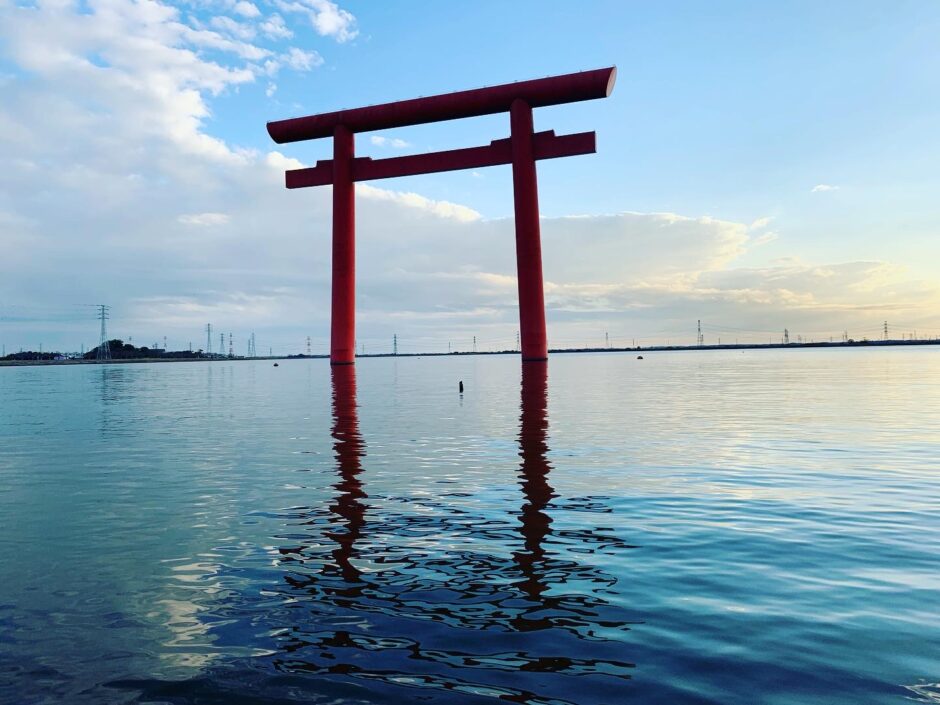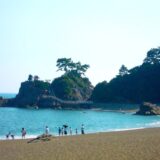【Kashima Jingu Shrine summary】
Kashima Jingu Shrine is the headquarters of approximately 600 Kashima shrines throughout Japan. It was built in 660 B.C. and is one of the three oldest shrines in the eastern part of Japan, along with the two other shrines in the eastern part of the country, the Katori Shrine and the Ikisu Shrine. Takemikazuchi Okami, the deity of the shrine, is known as the god of victory and martial arts, and many visitors come to the shrine to pray for victory and victory. The shrine is also known as the origin of the phrase “Kashima-dachi,” which means “to stand on Kashima Island,” and is a shrine that is visited when departing on a journey or at a turning point in one’s life.
The Ichino-torii (First Gate) on the west side of Kashima Jingu Shrine is the largest torii on water in Japan, measuring 18.5 m in height and 22.5 m in width. The sight of the vermilion torii reflected on the water is both divine and fantastic, and at dusk the torii shines even more beautifully in the setting sun.
【Kashima Jingu Shrine precincts】
The first torii (first shrine gate) is on the water and is not accessible on foot, so the second torii (second shrine gate) is the entrance to Kashima Jingu Shrine.
![Kashima Jingu Shrine [Ibaraki] DSC 1429 1024x768 - Kashima Jingu Shrine [Ibaraki]](https://japan-shrine.info/wp-content/uploads/DSC_1429-1024x768.jpg)
The previous version of the second torii gate was a stone gate made of granite from Kasama City, and was rebuilt in 1968 to commemorate the 100th anniversary of the Meiji Restoration, but it was destroyed by the Great East Japan Earthquake in 2011. The current torii gate was built using four giant cedar trees that had grown on the shrine grounds, and when it was completed in 2014, the stone from the collapsed torii gate was used as the base stone for the foundation.
After passing under the second torii gate, you will see the tower gate, which is a symbol of the Kashima Jingu Shrine, but as of the end of April 2024, it was undergoing renovation. We will visit the shrine again when the renovation work is completed.
![Kashima Jingu Shrine [Ibaraki] DSC 1433 1024x768 - Kashima Jingu Shrine [Ibaraki]](https://japan-shrine.info/wp-content/uploads/DSC_1433-1024x768.jpg)
Passing through the tower gate, visitors will find the shrine building, which consists of four buildings: the main hall, the Ishinoma (stone hall), the Mihiden (hall of offerings), and the hall of worship. It was donated by Hidetada, the second Tokugawa Shogun, in 1619 and is designated as an important cultural property. The worship hall is located almost at a right angle to the approach to the shrine, which is a curious positional relationship. It seems to be oriented in the direction of the North Star, but the details were unknown. On New Year’s Day, 2024, the cypress bark roof of the hall of worship was re-thatched. The worship hall has a simple yet solemn atmosphere.
![Kashima Jingu Shrine [Ibaraki] DSC 1482 1024x768 - Kashima Jingu Shrine [Ibaraki]](https://japan-shrine.info/wp-content/uploads/DSC_1482-1024x768.jpg)
The main shrine enshrines the “spirit of harmony” (nigoritama, or gentle spirit) of the deity Takemikazuchi Okami.
![Kashima Jingu Shrine [Ibaraki] DSC 1484 1024x768 - Kashima Jingu Shrine [Ibaraki]](https://japan-shrine.info/wp-content/uploads/DSC_1484-1024x768.jpg)
The sacred tree behind the main shrine is a huge old cedar estimated to be over 1,200 years old. The main shrine is wonderfully sculpted, and I had a good look at it. It is a pity that we could not get a closer look at the magnificent carvings.
![Kashima Jingu Shrine [Ibaraki] DSC 1442 1024x768 - Kashima Jingu Shrine [Ibaraki]](https://japan-shrine.info/wp-content/uploads/DSC_1442-1024x768.jpg)
【Kashima Jingu Shrine rear access road】
![Kashima Jingu Shrine [Ibaraki] DSC 1450 1024x768 - Kashima Jingu Shrine [Ibaraki]](https://japan-shrine.info/wp-content/uploads/DSC_1450-1024x768.jpg)
This approach road extends in a straight line from the Otorii (Grand Gate) location to the Okumiya Shrine. Originally, Okumiya was the main shrine, so the approach served to lead visitors to the main shrine. The forest within the precincts of the shrine, designated as a natural monument by the prefecture, is about 15 times the size of the Tokyo Dome and is home to many precious plants.
![Kashima Jingu Shrine [Ibaraki] DSC 1452 1024x768 - Kashima Jingu Shrine [Ibaraki]](https://japan-shrine.info/wp-content/uploads/DSC_1452-1024x768.jpg)
The approach to the temple is covered with huge trees in a vast forest, creating a very nice atmosphere. It is a perfect spot for forest bathing, strolling in the sunlight through the trees. All the trees are hundreds of years old, and the approach to the temple has such a majestic atmosphere that it makes the presence of human beings seem small.
【Kashima Jingu Shrine boulder formed from gravel and sediment, Deer Park】
![Kashima Jingu Shrine [Ibaraki] DSC 1454 1024x768 - Kashima Jingu Shrine [Ibaraki]](https://japan-shrine.info/wp-content/uploads/DSC_1454-1024x768.jpg)
The “Sazare-ishi( boulder formed from gravel and sediment)” stone, which is sung in the national anthem, is enshrined in the middle of the back approach to the shrine. It may not stand out in the spacious shrine grounds, but it is a place where visitors can learn the meaning behind the stone. There are many shrines with such a stone, but it is rare to find one so well maintained and decorated with the Japanese flag.
![Kashima Jingu Shrine [Ibaraki] DSC 1461 1024x768 - Kashima Jingu Shrine [Ibaraki]](https://japan-shrine.info/wp-content/uploads/DSC_1461-1024x768.jpg)
The deer park is home to more than 30 Japanese deer, the divine messengers of the Kashima Shrine. You can get close to the deer by purchasing food (carrots) for the deer for 100 yen at a nearby store. Speaking of deer, they are famous as divine messengers of Kasuga-taisha Shrine in Nara. When the Kasuga-taisha Shrine in Nara was founded, the spirit of Kashima-taishin was carried on the back of a white divine deer when the deity was invoked at Kasuga-taisha Shrine. Simply put, Kashima came first.
【Kashima Jingu Shrine rear shrine (located behind the main shrine, but dedicated to the same deity)】
![Kashima Jingu Shrine [Ibaraki] DSC 1480 1024x756 - Kashima Jingu Shrine [Ibaraki]](https://japan-shrine.info/wp-content/uploads/DSC_1480-1024x756.jpg)
The Okumiya Shrine(rear shrine (located behind the main shrine, but dedicated to the same deity)) is located at the end of the inner approach to the shrine. It is dedicated to the “spirit” of Takemikazuchi Okami (the god Takemikazuchi). The shrine was dedicated by Ieyasu Tokugawa as the main shrine, and later moved to this location when the present main shrine was dedicated by Hidetada Tokugawa, the second Shogun of the Tokugawa Shogunate. On weekends, there is a long line of people waiting for their turn to enter the shrine.
【Kashima Jingu Shrine Kanameishi】
![Kashima Jingu Shrine [Ibaraki] DSC 1466 1024x768 - Kashima Jingu Shrine [Ibaraki]](https://japan-shrine.info/wp-content/uploads/DSC_1466-1024x768.jpg)
Further on from the Okumiya Shrine is Kanameishi, the most powerful spot at Kashima Jingu Shrine for seismic protection. It is believed that earthquakes are caused by the rampaging of a catfish (or dragon) that lives underground, and Kanameishi is believed to hold the catfish in place. It also appears in the movie “Suzume”.
![Kashima Jingu Shrine [Ibaraki] DSC 1473 1024x768 - Kashima Jingu Shrine [Ibaraki]](https://japan-shrine.info/wp-content/uploads/DSC_1473-1024x768.jpg)
The part above ground is small, but the underground portion is huge and said to be impossible to pull out. It is also impressive that the Okumiya shrine is positioned to protect the keystone. The keystone of the Kashima Jingu Shrine is concave, while the Katori Jingu Shrine has a convex keystone that is connected to the ground. The keystone at Kashima is said to hold the head of a catfish, while the one at Katori holds its tail.
【Kashima Jingu Shrine GOSHUIN】
![Kashima Jingu Shrine [Ibaraki] 2024 05 05 18 51 Office Lens 707x1024 - Kashima Jingu Shrine [Ibaraki]](https://japan-shrine.info/wp-content/uploads/2024_05_05-18_51-Office-Lens-707x1024.jpg)
![Kashima Jingu Shrine [Ibaraki] 2024 05 05 18 52 Office Lens 729x1024 - Kashima Jingu Shrine [Ibaraki]](https://japan-shrine.info/wp-content/uploads/2024_05_05-18_52-Office-Lens-729x1024.jpg)
【Kashima Jingu Shrine Nearby attractions】
![Kashima Jingu Shrine [Ibaraki] DSC 0135 160x160 - Kashima Jingu Shrine [Ibaraki]](https://japan-shrine.info/wp-content/uploads/DSC_0135-160x160.jpg) Katori Jingu Shrine [Chiba]
Katori Jingu Shrine [Chiba]
【Kashima Jingu Shrine Access】
Manager’s Comments
The approach to the shrine, covered with huge trees, leads through a vast 70-hectare forest on the grounds. In addition to the shrine pavilions and the Okumiya shrine, there were many attractions such as Mitarashi Pond, where misogi is also performed with spring water, a deer garden with many deer, and Yoseki, a keystone buried deep underground to keep catfish, which can cause earthquakes, at bay. We recommend that you visit the shrine early, as by the time 9:00 a.m. rolls around, there is quite a long line of people waiting to get in.
2306-1 Miyanaka, Kashima-shi, Ibaraki 314-0031
※Parking lot for worshippers available
 Tour of Japanese shrines and temples
Tour of Japanese shrines and temples 

